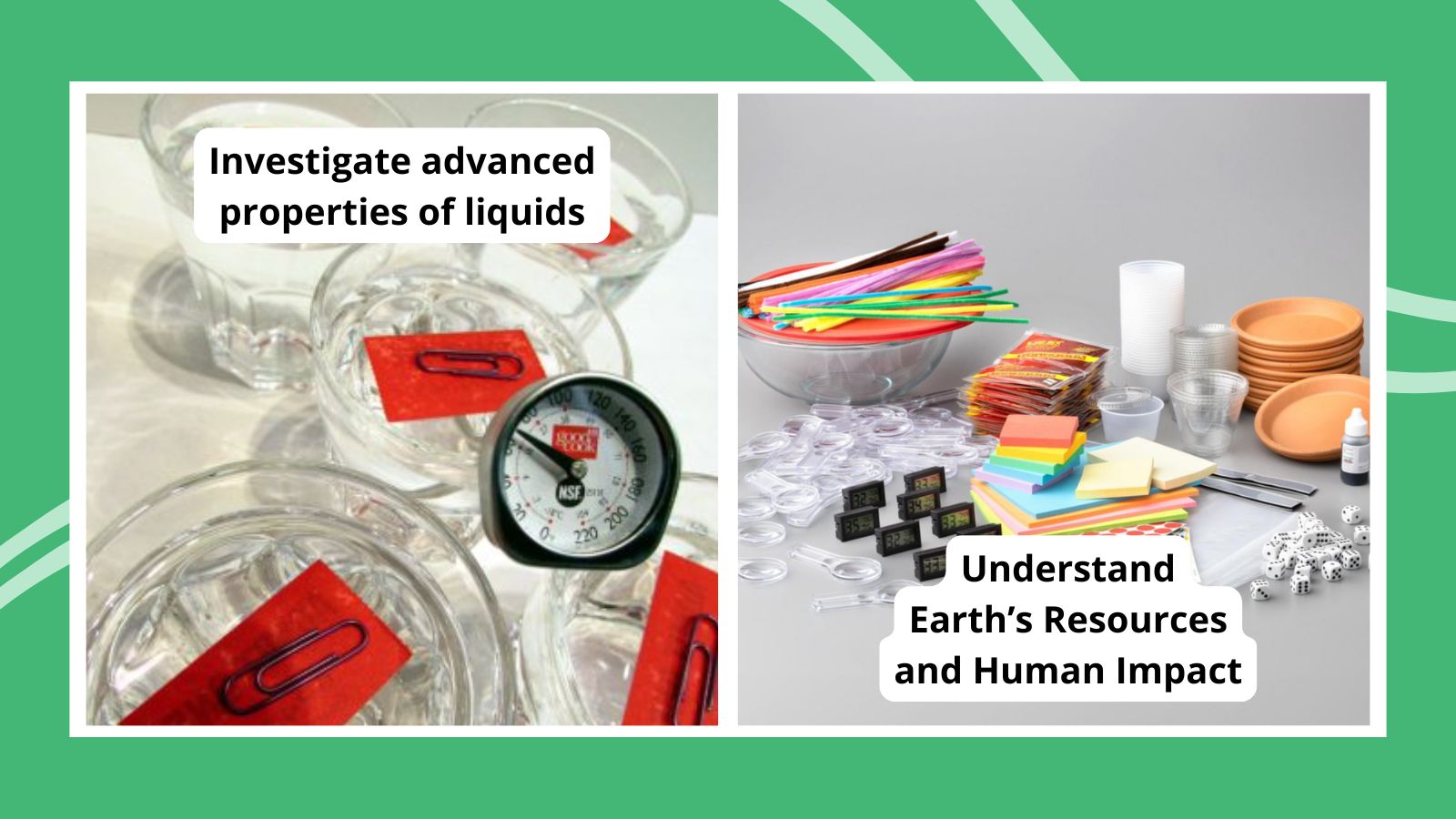Whether your students are preparing for the science fair or you’re looking for classroom ideas to grab their interest, we’ve got you covered! This list of 8th grade science fair projects and experiments has projects from biology to physics, from easy to difficult. Plus, check out fun classroom demos and hands-on experiments and activities your students will love.
To make it easier to find classroom activities or science fair projects for 8th graders, we’ve rated all the projects and activities by difficulty and the materials needed:
Difficulty:
- Easy: Low or no-prep experiments you can do pretty much anytime
- Medium: These take a little more setup or a longer time to complete
- Advanced: Experiments like these take a fairly big commitment of time or effort
Materials:
- Basic: Simple items you probably already have around the house
- Medium: Items that you might not already have but are easy to get your hands on
- Advanced: These require specialized or more expensive supplies to complete
Jump to:
- Biology and Life Science 8th Grade Science Fair Projects
- Chemistry 8th Grade Science Fair Projects
- Physics 8th Grade Science Fair Projects
- Engineering 8th Grade Science Fair Projects
Biology and Life Science 8th Grade Science Fair Projects
Explore human behavior, plants and animals, the water cycle, and more with these 8th grade science fair project ideas.
Ward’s Science OpenSciEd Kit: Earth’s Resources & Human Impact
Difficulty: Medium / Materials: Basic (Everything is provided for you!)
Absolutely perfect for teachers using OpenSciEd’s free curriculum for middle school classes, but this awesome classroom activity kit can also be used by any teacher working with their students on subjects like human impact on Earth’s resources and climate solutions.

Measure and compare lung capacity
Difficulty: Easy / Materials: Medium
This experiment combines math and biology to measure lung capacity using a balloon. There are a lot of interesting hypotheses students can form, document, and explore while taking these measurements.
Learn more: How To Measure Lung Capacity

Guide a growing plant through a maze
Difficulty: Medium / Materials: Basic
Prove that plants really do seek out the light by setting up a simple or complex maze. Then, put a potted plant at the start of the maze, provide sunshine at the other end, and observe what happens. This is a simple 8th grade science project with really cool results.
Learn more: Plant Light Maze

Test water quality
Difficulty: Easy / Materials: Medium
A water-testing kit opens up limitless options for 8th grade science fair projects. Test the water quality of local streams, swimming pools, or even the taps at home.
Buy it: Water Test Kit

Cast animal tracks
Difficulty: Medium / Materials: Medium
Explore wildlife biology by becoming an expert tracker. Learn to identify tracks and take casts. Turn this into an experiment by trying different methods to take casts, or use it as a method of identifying wildlife in the woods.
Learn more: Find and Collect Animal Tracks
Determine a plant’s favorite music
Difficulty: Easy / Materials: Medium
Play different types of music for plants, then observe and document any changes in the growth and development of the plants as they’re exposed to different genres of music.
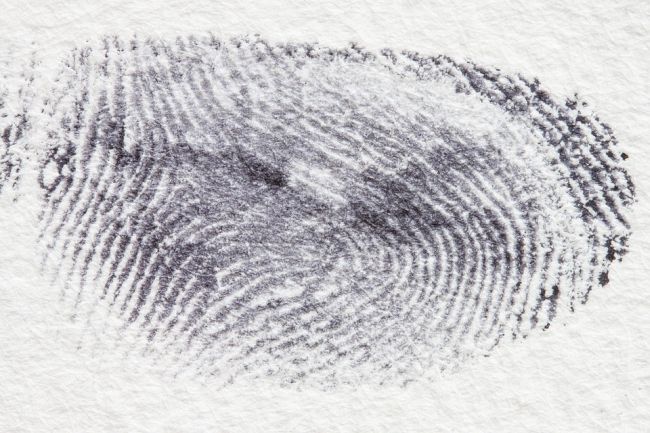
Conduct fingerprint analysis
Difficulty: Medium / Materials: Medium
Budding forensic scientists will love this idea. Learn to dust for prints and try a technique called “fuming” for trickier surfaces. See if you can compare prints and make accurate matches in the classroom.
Buy it: Fingerprint Kit at Amazon
Learn more: Fingerprinting
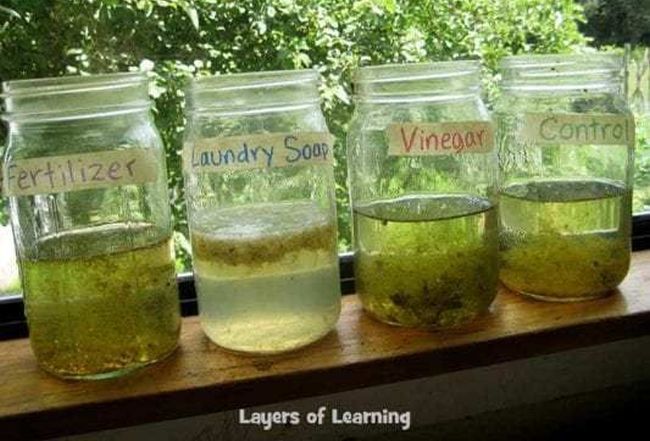
Measure algae growth
Difficulty: Medium / Materials: Medium
Fertilizer runoff has become a serious cause of water pollution. In this experiment, students will see its effects firsthand and brainstorm ways to keep it in check.
Learn more: Algae and Pollution Experiment

Water plants with different liquids
Difficulty: Easy / Materials: Medium
In this easy science fair project, kids water plants with different liquids, like rainwater, tap water, salt water, and even soda. They might be surprised at the results!
Learn more: Effecting Plant Growth

Do plants need light?
Difficulty: Easy / Materials: Basic
The answer seems obvious, so the experiment and presentation is to figure out why plants need light and to explain photosynthesis. In this experiment, students create different light conditions and see if plants can grow in each.
Learn more: Do Plants Need Light?

Observe capillary action
Difficulty: Easy / Materials: Basic
This is the classic celery-and-colored-water demonstration. Eighth graders can focus on explaining capillary action and how it works in this example and others.
Learn more: How Plants Drink Science Experiment

Examples of symbiosis
Difficulty: Easy / Materials: Basic
This project is about understanding and presenting the concept of mutualism and symbiosis. Students design and explain two animals that live in a symbiotic relationship. This is a great way to use a 3D printer if you have one.
Learn more: Symbiosis Project
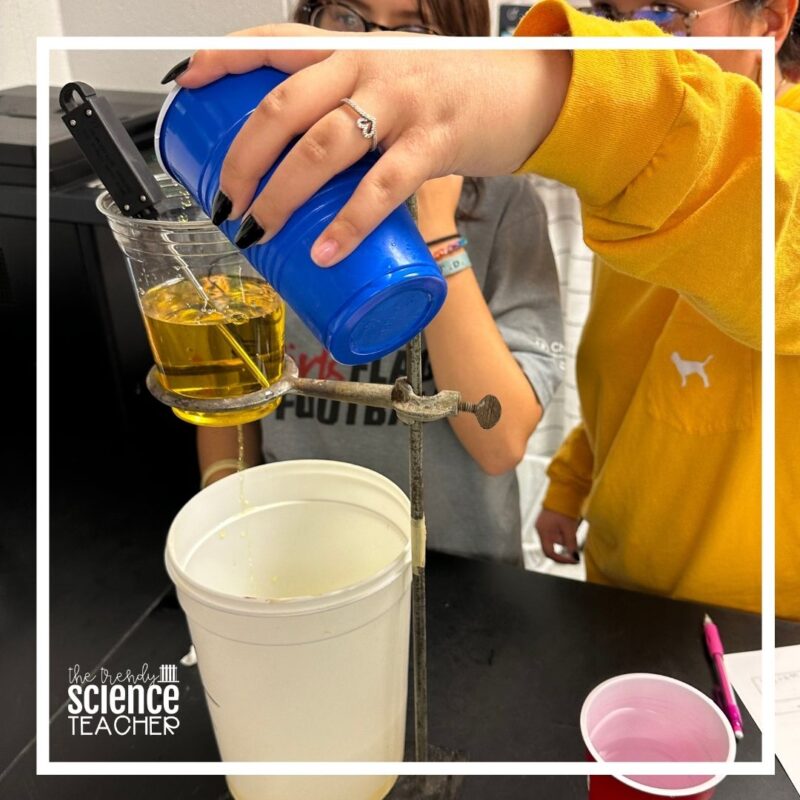
Demonstrate homeostasis
Difficulty: Medium / Materials: Medium
Students learn about homeostasis and how to create a compound that is in homeostasis.
Learn more: Homeostasis Experiment
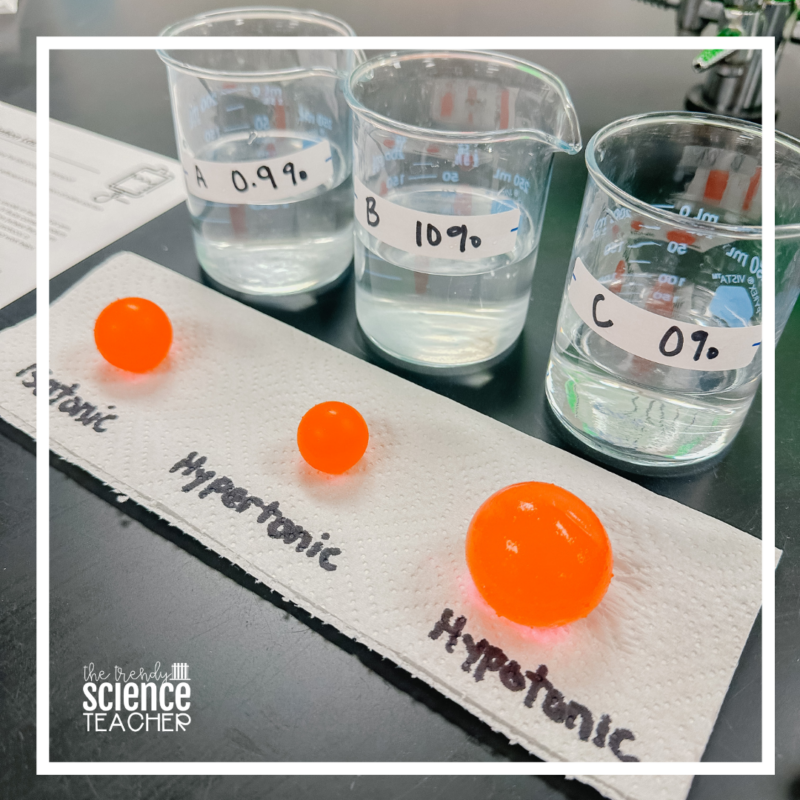
Simulate osmosis with water beads
Difficulty: Easy / Materials: Medium
Demonstrate what happens to water beads when they are in different solutions—isotonic, hypertonic, and hypotonic.
Learn more: Osmosis Simulation

Explain cell membranes with bubbles
Difficulty: Easy / Materials: Basic
Explain how cell membranes work using bubbles. This fun demonstration is a great way for students to engage participants at the science fair.
Learn more: Cell Membrane Bubble Lab
Grow plants from scraps
Difficulty: Easy / Materials: Basic
This is a great science project that engages students in thinking about how plants grow, ways to reuse and recycle plant material, and the larger topics of how to reduce food waste.
Extract DNA from an onion
Difficulty: Medium / Materials: Basic
After studying DNA, students can extract DNA from an onion. This is a simple way to practice following procedures and explain what DNA is.
Model the greenhouse effect
Difficulty: Easy / Materials: Basic
Show how greenhouse gasses trap heat with this demonstration that uses various gasses in glass jars and a thermometer to show what happens as the gas collects.
Show the carbon cycle
Difficulty: Easy / Materials: Basic
Another way to show the greenhouse effect is by showing the carbon cycle. For 8th graders, explaining and modeling the carbon cycle is a good way to build on their understanding of cycles.
Plant seed dispersal methods
Difficulty: Easy / Materials: Basic
In this experiment, students study how seeds are dispersed and explore the results of different dispersal methods.
Observe plasmolysis
Difficulty: Medium / Materials: Advanced
Use red onions to show plasmolysis. Put the onion on a cell slide and add salt water. After a few minutes, students can observe plasmolysis. Add pure water to reverse the reaction.
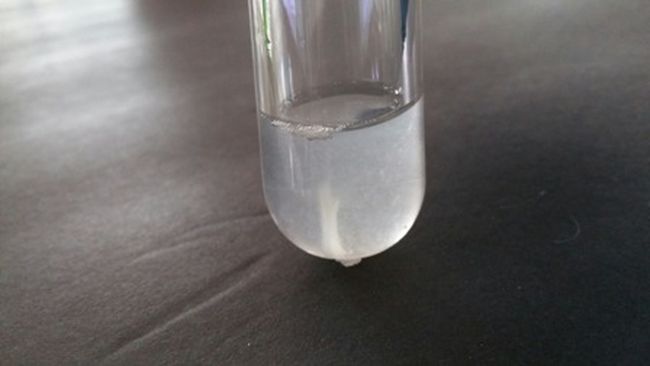
Extract your own DNA
Difficulty: Medium / Materials: Medium
DNA is the blueprint of life, and you’ll be surprised at how easy it is to extract your own with a few simple supplies. Preserve it in alcohol in the freezer when you’re done.
Learn more: How To Extract DNA at Home
Chemistry 8th Grade Science Fair Projects
Beakers and test tubes, pouring and mixing … do it all with these fun chemistry science fair project ideas for 8th graders.
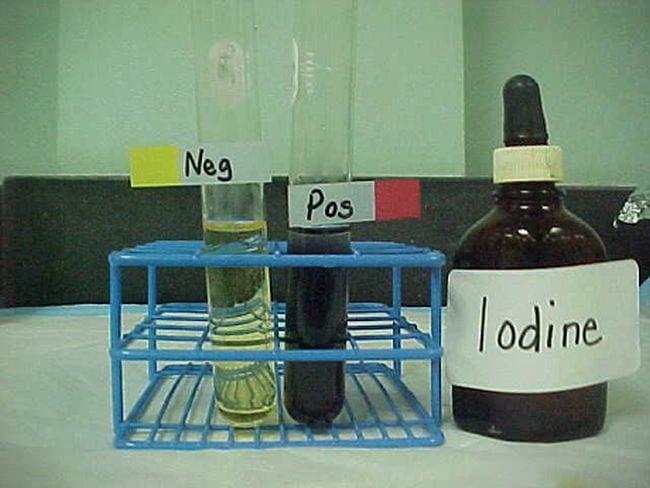
Perform a starch test with iodine
Difficulty: Medium / Materials: Medium
This simple chemistry experiment uses iodine to determine the starch content of food items. Use the process to perform a variety of 8th grade science experiments related to food.
Learn more: Starch Test

Keep your hands warm
Difficulty: Medium / Materials: Medium
If you live in a chilly part of the world, chances are you’ve seen chemical hand warmers for sale. In this 8th grade science fair project, use oxidation to make your own hand warmer, and find other creative ways to use this heating process.
Learn more: Homemade Hand Warmer
Compare electrolytes in sports drinks
Difficulty: Medium / Materials: Medium
Sports-loving kids will enjoy the chance to learn just how many valuable electrolytes their favorite sports drinks contain. Compare them with water or orange juice for a cool science fair project. You’ll need a few special supplies, like a multimeter and an ohm resistor, but they’re not too expensive.
Buy it: Multimeter and Ohm Resistor at Amazon
Turn juice into spheres
Difficulty: Medium / Materials: Medium
You’ll need a few special supplies for this experiment, but the results are so cool. Turn spherification into a science fair project by experimenting with different beverages and liquids.
Buy it: Spherification Kit at Amazon
Block the sun’s UV rays
Difficulty: Easy / Materials: Medium
Use color-changing UV beads to test the protective power of medicine bottles, hats, clothing, and more. This is an easy 8th grade science fair project with nearly endless possibilities.
Buy it: UV Beads at Amazon
Grow a carbon sugar snake
Difficulty: Medium / Materials: Medium
Remember those little black pellets that fire up into long snakes on the 4th of July? This is the same concept but much bigger! The simple chemical reaction of sugar and baking soda makes it happen. Turn this into an 8th grade science fair project by varying the formula to create even bigger results!
Create a rainbow of flames
Difficulty: Medium / Materials: Medium
You can change the color of fire by adding chemicals found at your local grocery store—what a sight! How can you use these flame colors to determine the chemical content of other materials? Sounds like a cool 8th grade science fair project!
Study the effects of acid rain
Difficulty: Easy / Materials: Basic
In this project, students use chalk as a stand-in for stone to learn how acid rain affects buildings, statues, and more. Turn this into a science fair project by exploring ways to mitigate the effects of the acidity.
Extract bismuth from Pepto Bismol
Difficulty: Advanced / Materials: Advanced
This is the kind of project that really makes you feel like a scientist. Grinding tablets with a mortar and pestle, filtering in beakers, heating over a Bunsen burner … this is what chemistry is all about!

Optimize fermentation temperature
Difficulty: Easy / Materials: Basic
Delve into the mystery of how temperature affects the fermentation process and determine the optimum temperature for yeast development. (Test your hypothesis by baking a loaf of bread!)
Learn more: Hot Yeast Experiment

Brew up some root beer
Difficulty: Medium / Materials: Medium
Who says science can’t be delicious? Tinker with the basic root beer recipe to make it sweeter, fizzier, or better in any way you like!
Learn more: Homemade Root Beer
Magic milk experiment
Difficulty: Easy / Materials: Basic
Students show how adding dish soap to milk changes the chemical bonds, creating hydrophobic and hydrophilic molecules that create the chasing, swirling effect.
Learn more: Magic Milk Experiment
Balloon baking soda experiment
Difficulty: Easy / Materials: Basic
This classic science fair project can be elevated for 8th graders by focusing on why the chemical reaction occurs the way it does, and encouraging them to get creative with ways that they can make this reaction work to move a car or rocket.
Learn more: Balloon and Baking Soda Experiment
Elephant toothpaste
Difficulty: Easy / Materials: Basic
Another chemical reaction experiment that students can do that has a dramatic result.
Learn more: Elephant Toothpaste Experiment
Egg and vinegar experiment
Difficulty: Easy / Materials: Basic
Show what happens when an egg is in an acidic solution. This is a cool experiment to talk about chemical reactions, in this case the reaction that dissolves the outside of an egg.
Learn more: Egg and Vinegar Experiment
Make a lava lamp
Difficulty: Easy / Materials: Basic
Create a lava lamp using chemical reactions. This demonstration can be created right at the science fair, making it a good one to explain to participants.

Create candy geodes
Difficulty: Medium / Materials: Basic
Students show the process of crystallization by creating candy geodes, a fun spin on the rock candy experiment.
Learn more: Candy Geodes
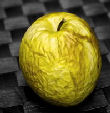
Mummify an apple
Difficulty: Easy / Materials: Basic
In this experiment, students remove the moisture from an apple and don’t let bacteria grow.
Learn more: Apple Mummy
Extinguish a candle without blowing it out
Difficulty: Medium / Materials: Medium
Combine an acid-base experiment with some fire science in this really popular classroom science demo. It seems like magic, but it’s just science!
Exploding lunch bag
Difficulty: Easy / Materials: Basic
This demonstration shows the dramatic reaction between an acid and a base. Fill the bag with the ingredients, shake, and step back.
Make and test slime
Show how chemicals coming together can make more chemicals. Students can get creative in how they combine the slime ingredients to make their own version.
Learn more: How To Make Slime
Investigate advanced properties of liquids
Difficulty: Easy / Materials: Basic
Water is an interesting molecule. Eighth graders can explore it with different experiments and demonstrations. They can answer questions about whether surface tension and viscosity decrease with increasing temperature.

Relight a candle without touching it
Difficulty: Easy / Materials: Medium
Tell students you’re going to relight a candle without touching the flame to the wick. The results will boggle their minds!
Learn more: Magic Traveling Flame

Candle carousel
Difficulty: Easy / Materials: Basic
Model heat conduction and show how heat creates energy with this fun carousel project.
Learn more: Candle Carousel Experiment
Physics 8th Grade Science Fair Projects
For those who love to build and tinker, try a science fair project that experiments with various physics concepts like energy, electricity, motion, and more.

Build a better light bulb
Difficulty: Medium / Materials: Medium
First, use the steps at the link to build a simple light bulb with a jar, some wire, and a 6-volt battery. Then, turn it into an 8th grade science fair project by tinkering with the various materials to make a light bulb that lasts longer, burns brighter, or is powered by an alternative source.
Learn more: Build a Light Bulb
Buy it: 6-volt battery at Amazon
Test the strength of interleaved paper
Difficulty: Medium / Materials: Basic
Paper seems smooth and slides apart easily, right? Not when you add friction into the mix! MythBusters was amazed at how much strength it took to pull apart two interleaved phone books. Try this with smaller books for an 8th grade science fair project that people won’t believe!
Cook up a tasty treat with solar energy
Difficulty: Medium / Materials: Medium
Students can design and build a solar oven, and then use it to cook food to compare the cooking time and temperature with a conventional oven. See if you can improve on the original design by changing up the materials or construction.
Learn more: Solar Oven Science Project
Make a solar desalinator
Difficulty: Medium / Materials: Medium
Clean fresh water is a valuable commodity. Construct solar-powered desalination devices with readily available materials, and find the most effective desalination methods.

Capture a picture of lightning
Difficulty: Advanced / Materials: Medium
Lichtenberg figures capture the branching path of electricity as it travels through an object. You can make your own in a variety of ways, including burning it into wood or acrylic.
Learn more: Lichtenberg Figures

Discover the center of gravity
Difficulty: Medium / Materials: Medium
Once you find and maintain its center of gravity, almost any object will balance, even in surprising circumstances. Using this concept, what amazing objects can you balance and where?
Learn more: Center of Gravity Experiment
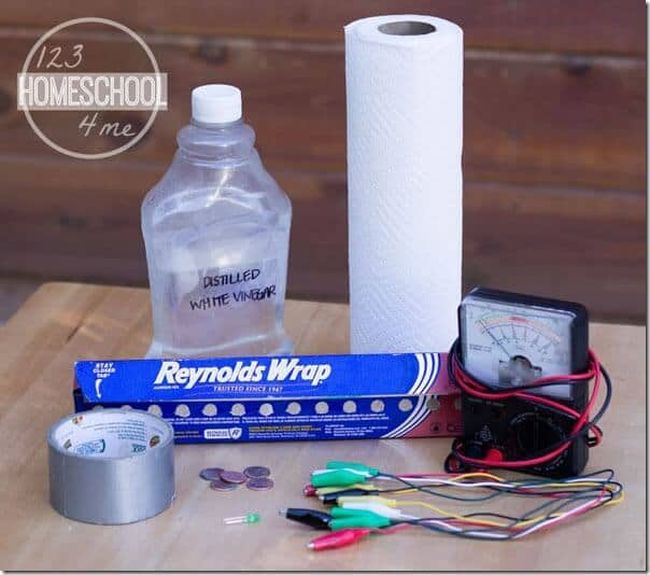
Power up homemade batteries
Difficulty: Medium / Materials: Medium
Building batteries is a classic science experiment for any age. Make it into an 8th grade science fair project by trying different variables and exploring the amount of power you can produce.
Learn more: DIY Batteries
Assemble a spring balance scale
Difficulty: Medium / Materials: Medium
Apply Hooke’s law to find out if the stretching of a spring can be used to accurately measure the weight of objects. The materials are simple, but you’ll need patience and physics to calibrate a spring and use it to test weights.
Build an infinity mirror
Difficulty: Advanced / Materials: Medium
Experiment with optical illusions by creating a tunnel of lights that seems to stretch away into infinity. Eighth grade science students will learn about engineering and the physics of optics along the way.
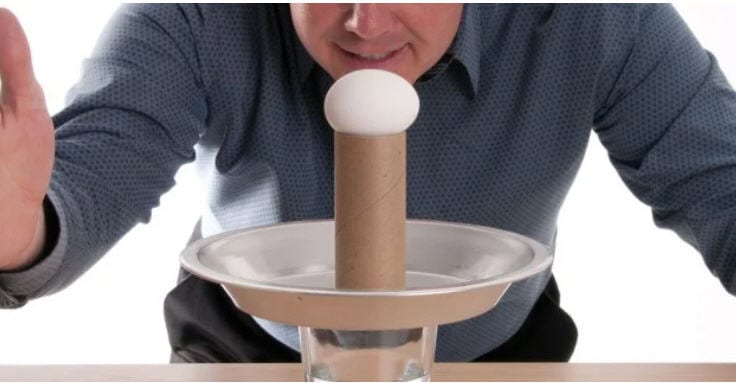
Drop an egg to prove the first law of motion
Difficulty: Easy / Materials: Medium
This experiment looks like a magic trick, but it’s firmly grounded in Newton’s first law of motion. When you knock the pie tin out of the way, the egg falls straight into the glass thanks to inertia. (Worried about making a mess? Use plastic eggs instead.)
Learn more: Egg Drop Inertia Challenge
Break out the leaf blower to teach Bernoulli’s principle
Difficulty: Easy / Materials: Medium
Eighth grade science students have probably seen a Bernoulli demo or two, often with straws and Ping-Pong balls. So grab their attention by trying it with a leaf blower and beach ball instead!

Assemble a Newton’s cradle
Difficulty: Medium / Materials: Medium
Newton’s cradle is a fascinating way of demonstrating momentum and energy transfer. Follow the directions at the link to build one, or challenge 8th grade science students to experiment with their own construction methods.
Learn more: Newton’s Cradle
Demonstrate the “unpoppable” balloon
Difficulty: Easy / Materials: Medium
Your students won’t believe you when you say you can hold a balloon up to a flame without popping it. Use the conductivity of water to prove your point.
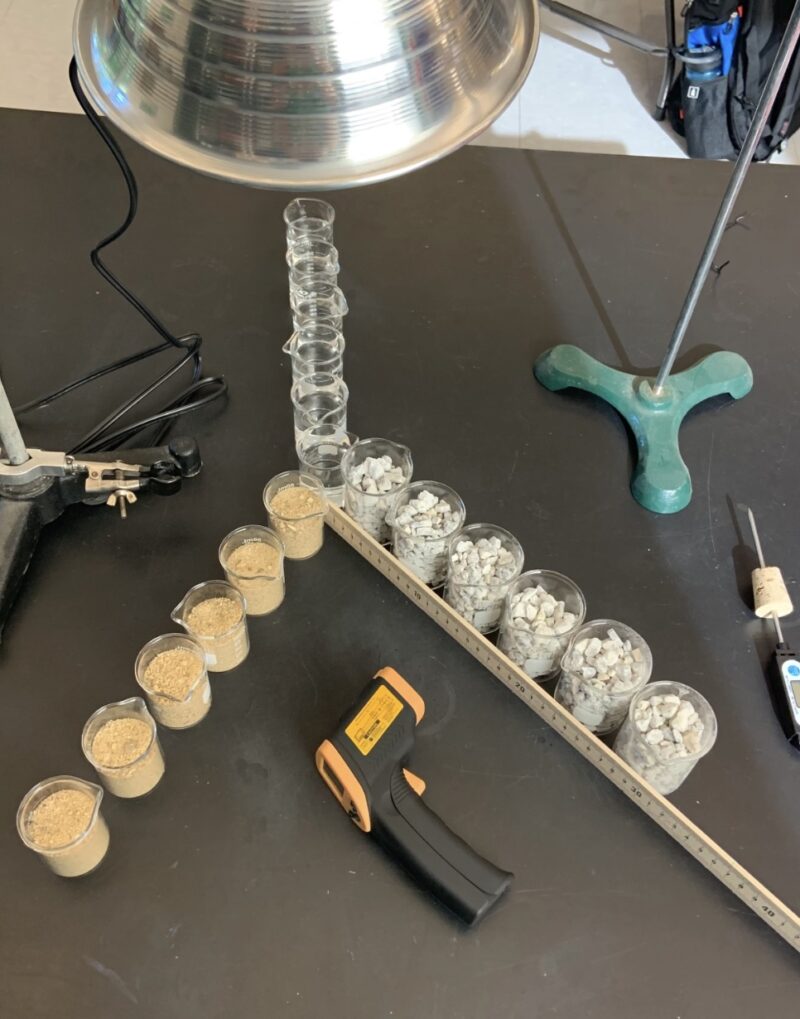
Measure surface temperature
Difficulty: Easy / Materials: Medium
Students measure and track the differences in surface temperature when various materials are put under a heat lamp.
Learn more: Surface Temperature Lab
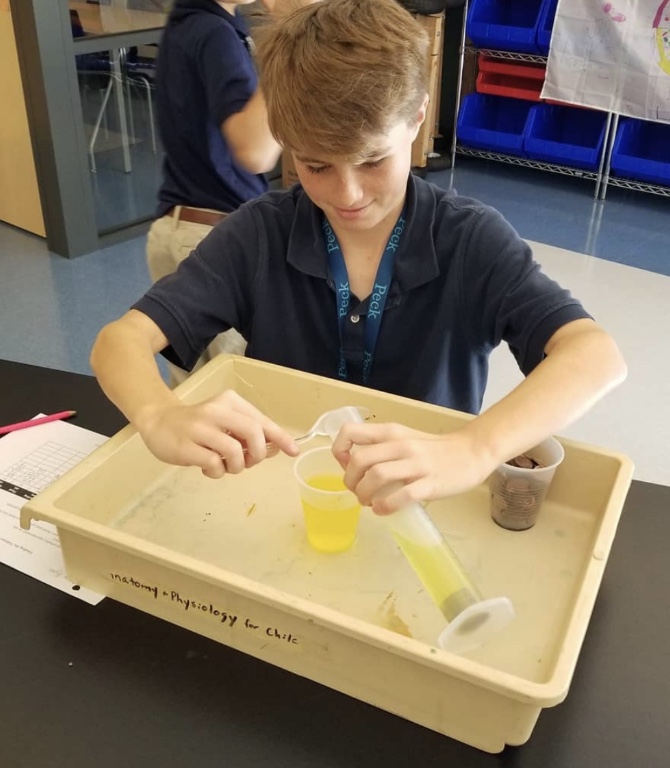
Measuring the volume of pennies
Difficulty: Easy / Materials: Basic
This experiment combines math and science as students use the displacement of water to calculate the volume of a penny and a stack of pennies.
Learn more: Volume of a Penny Lab

Make a seismograph
Difficulty: Medium / Materials: Medium
There’s a lot students can do with earthquakes. They can create and test a structure that could withstand an earthquake or make a seismograph. Either way, this project will shake it up!
Learn more: Earthquake STEM Challenge
Egg drop challenge
Difficulty: Medium / Materials: Basic
Even if you’ve done the egg drop challenge in class, some students might like to explore the principles and science behind it for the science fair. The trick, for the fair, is to be able to explain what students are doing and why they are making those decisions as they cushion or protect their egg.
Learn more: Egg Drop Challenge Ideas
Engineering 8th Grade Science Fair Projects
Engineering projects are a great way to bring math and science together for students who love to build, build, build!
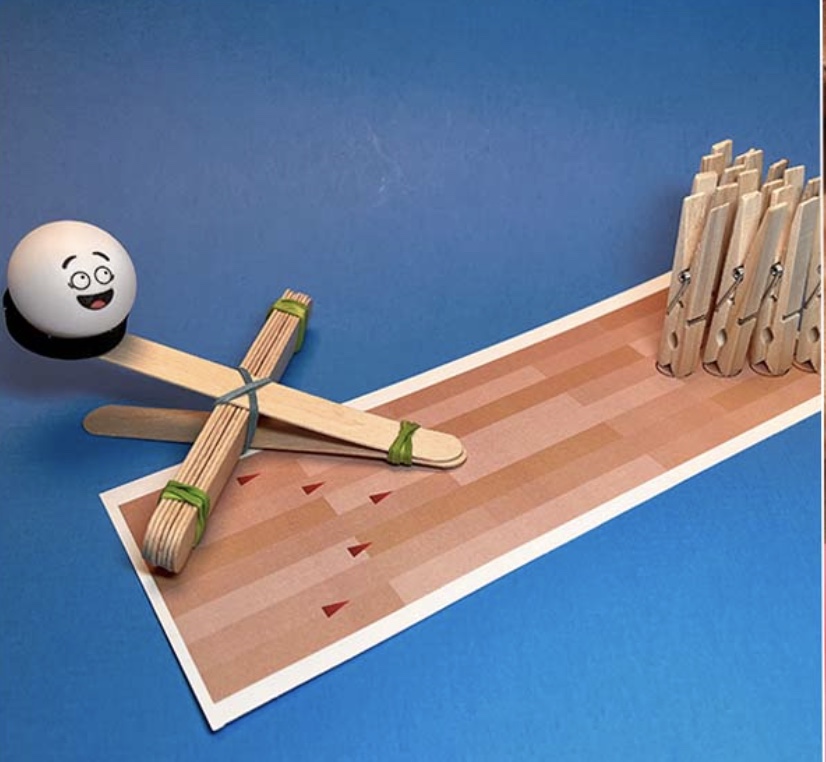
Make catapults
Difficulty: Medium / Materials: Basic
Demonstrate principles of movement with catapults. This project is a great way for students to learn about movement and trajectory. Students can experiment with different ways to build catapults that produce large and small trajectories, and invite participants to try out their catapults too.
Learn more: Catapult Project
Navigate a light maze
Difficulty: Medium / Materials: Basic
Here’s the STEM challenge: Bounce a beam of light around a corner past an obstacle. Increase the difficulty by adding more obstacles and variables.
Create a magnet maze
Difficulty: Easy / Materials: Basic
Combine engineering and magnets with this project. Students create a maze that requires them to use a magnet to navigate through.
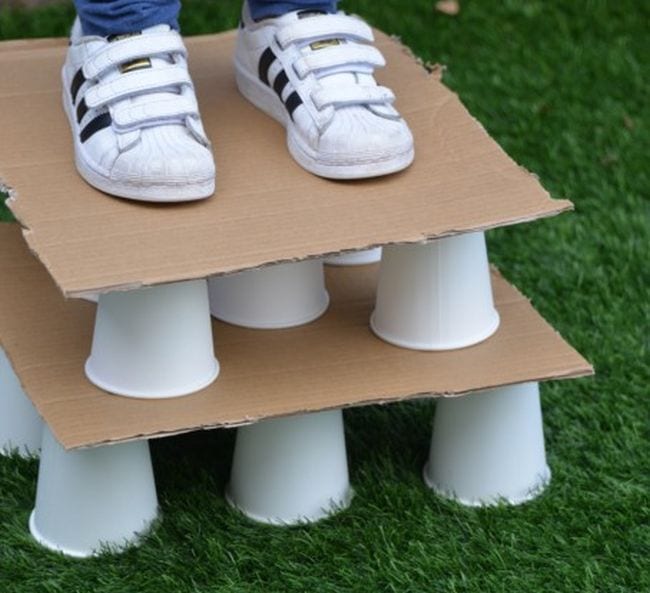
Stand on a pile of paper cups
Difficulty: Medium / Materials: Basic
Combine physics and engineering and challenge 8th grade science students to create a paper cup structure that can support their weight. This is a cool project for aspiring architects.
Learn more: Stand on a Paper Cup
Create an electric circuit game
Difficulty: Medium / Materials: Medium
Students learn how to create an electrical circuit and combine multiple circuits to create a game. So fun!
Difficulty: Medium / Materials: Basic
Create a wind-powered car
Difficulty: Easy / Materials: Basic
A great opportunity to use a 3D printer if you have one, creating a wind-powered car teaches students about engineering and physics.
Protect an egg in a crash
Difficulty: Medium / Materials: Medium
We love this spin on the classic egg-drop project. In this version, students build a structure to protect an egg during a collision with a wall, making the connection between crash tests and physics concepts.
Construct a Rube Goldberg machine
Difficulty: Advanced / Materials: Medium
Create a machine to complete a simple task in the most complicated fashion! This is a neat 8th grade STEM fair project because it allows you to use a variety of physics concepts in a fun way.
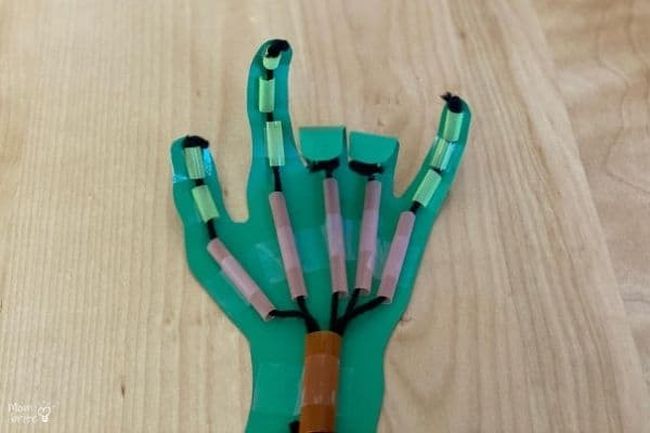
Design a robotic hand
Difficulty: Medium / Materials: Medium
This is a project that can be tweaked by coming up with ways to improve upon the design. Can you build a hand that can pick up a ball? How about one that can pluck up a piece of string? So many possibilities!
Learn more: DIY Model Robot Hand STEM Activity
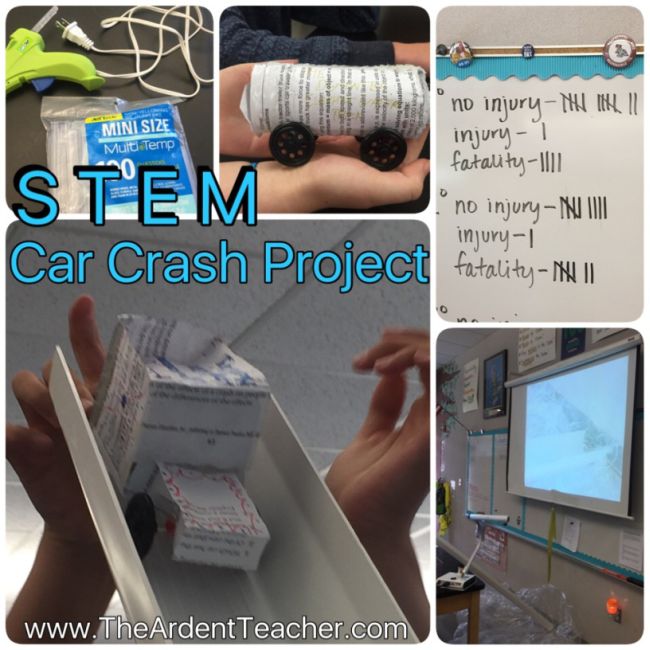
Crash cars for science
Difficulty: Medium / Materials: Medium
This is a great class project for teachers, but it’s also excellent for an 8th grade science fair project. Build cars and crash-test them to learn the best methods of keeping passengers safe.
Learn more: STEM Car Crash Project
Engineer a roller coaster loop
Difficulty: Medium / Materials: Medium
Kids may have created roller coasters with marbles before, but have they ever built one with a loop-the-loop? They’ll have to experiment to find out which initial height gives a marble the speed it needs to complete the journey.
Build a trash can air cannon
Difficulty: Medium / Materials: Medium
This is such a fun way to demonstrate an air vortex! It takes a little effort to build the air cannon, but you can use it year after year for amazing 8th grade science demos.

Separate water into hydrogen and oxygen
Difficulty: Medium / Materials: Medium
Use electrolysis to prove that water really is made up of hydrogen and oxygen. It’s a simple concept but one that never fails to amaze.
Learn more: Separating Water Into Hydrogen and Oxygen
Assemble a ring of Pringles
Difficulty: Medium / Materials: Medium
Everybody loves an edible STEM challenge! Here’s one that seems simple but takes some time to work out: Build a ring of Pringles chips without using any other materials.

Construct a cup holder
Difficulty: Medium / Materials: Basic
Can your 8th grade science students build a device to stabilize and carry two cups of water using only a few simple supplies? Oh, and can they manage it in just 5 minutes? This timed challenge pushes their creative engineering limits!
Learn more: Cup Holder STEM Challenge
Make solar oven s’mores
Difficulty: Medium / Materials: Basic
Demonstrate the principle of converting solar radiation into heat in the yummiest way possible by having your students construct their own solar ovens and baking s’mores using nothing but the light from the sun.
Learn more: Solar Oven Experiment
Check out even more ready-to-go science kits for hands-on learning your students will love
Ward’s Science OpenSciEd kits come with every item you need to start exploring with your students immediately. Your students will develop their critical questioning, research, and teamwork skills while working to solve problems that feel real and important.
